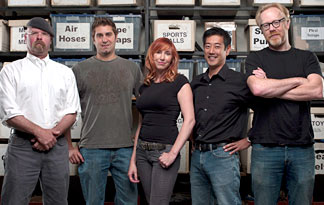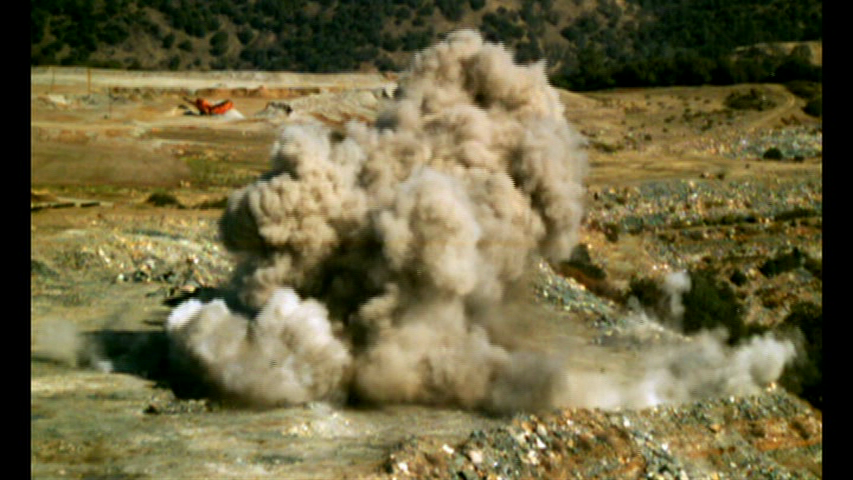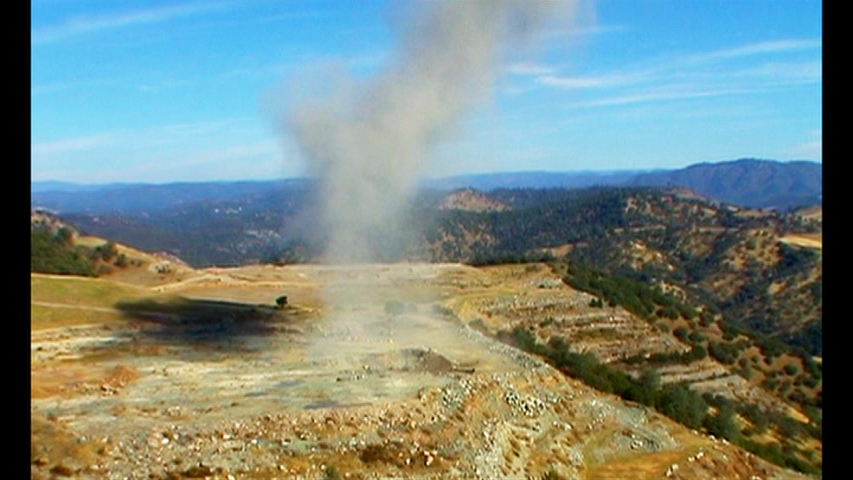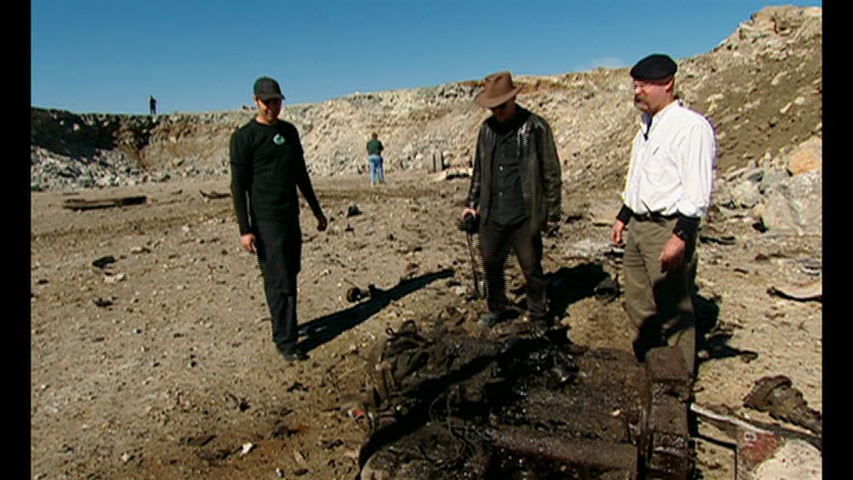It’s a Myth So Let’s Blow It Up: The Pleasures of Mythbusters
Janet Staiger / University of Texas at Austin

Several issues ago in Flow, Ann Johnson provided an excellent analysis of the hypothesis-testing structures of Mythbusters (2003-).1 I have seen nearly every episode of the program and agree. An episode starts with a “myth” (actually usually two which are presented through cross-cutting), a discussion of some of the science that might be involved, a building of an apparatus or set of procedures to test the myth, and then its confirmation–or not. While the production team certainly is counting on “a faith in a public appetite for reason” as Johnson phrases it, this is not quite the Watch Mr. Wizard (1951-65) of my childhood. Three characteristics beyond rational reasoning enhance the entertainment value: the use of the formulas of the detective genre, the narrator’s commentary, and, most of all, excess.
A Mythbusters narrative arc almost always begins with someone bringing a myth to the team to solve. From the start the “first” team has been Jamie Hyneman and Adam Savage; over the series other teams have developed so that for the last several years the “second” team is Tori Belleci, Kari Byron, and Grant Imahara. A test dummy, Buster, assists.

Those bringing the myth are often viewers who send in suggestions; however, even President Obama asked Jamie and Adam to re-investigate the Ancient Death Ray myth which had been busted in an earlier episode.2 Just as clients or Inspector Lestrade or an important person from the royal family may initiate a case with Sherlock Holmes, most of the jobs come in from the outside. Drawing on their areas of expertise (both Jamie and Adam have been movie stunt men), the team considers the known facts and works out methods to solve the puzzle.
At times the team members can be put into danger, creating the pleasurable affect of suspense. In “Sinking Titanic” (air date 22 February 2004), Adam needs to sit on a boat to determine if he will be sucked down when it sinks, and Jamie is in murky San Francisco waters trying to attach cables to the boat to bring it back up for further tests. Our empathy is, as in the detective genre, with the investigators, and with the exception of a few minor scraps, everyone has been okay. For viewers, the detective-genre pleasures also involve using our own intelligence and knowledge of science to speculate in advance about the results, either being confirmed in our evolving hypotheses or surprised. One scholar of detective fiction states that the genre’s narrative trajectory involves “a battle of wits between the curious reader, who endeavors to beat the author . . . to the solution, and the author who does his utmost to mystify, misdirect, and baffle him.”3 Here, everyone–team and viewers–wonders about the outcome and is rewarded at the same moment.
Although not always a pleasure for me, the producers of Mythbusters have used a voice-over narrator (Robert Lee in the U.S.) to explain, recap, and comment about the action. Many of his remarks are (to me, silly or gratuitous) jokes about the team members or puns about what is happening. Given that at least two myths are being pursued in parallel and that commercial breaks interrupt the action, recaps are useful as is explanation beyond the conversation among the team members. I imagine the comedy is pleasurable to many people. Its saucy tone does create some intimacy as the narrator reveals and reminds us about the personalities of the investigators. It also is quite at a distance from the hard-boiled detective genre’s objective narration. This easy, not-much-is-really-at-stake tone also supports the third pleasure.
If an episode ended with “busted,” “plausible,” or “confirmed,” the program would probably be successful. However, I do not think that is what draws spectators to watch. It is not rational hypothesis-testing and puzzle-solving but the excess that happens after that. As Jamie remarks in “Salsa Escape” (air date 23 February 2005), “This has got nothing to do with the myth. It’s just a big boom.” Anyone who scans the episode descriptions will notice how many times explosions are featured. As the narrator remarks in another episode, “if it’s worth doing, it’s worth overdoing.”4 Most narrative arcs–at least in terms of spectacle–end “too soon.” The team justifies this “going-on” by changing the question from whether the myth is true to what it would take to replicate the results the myth implied.
For example, in “Salsa Escape,” one myth being tested is whether people can clean out a cement truck using a stick of dynamite. After pouring out cement, a crust of one to two inches develops in the interior of the drum. So, rather than hand-chipping it out, can explosives do the job? Jamie, Adam, and explosive experts start small: a cherry bomb and then an M-80 (equivalent to 1/4 stick of dynamite). Nothing happens. As a team member says, and which will be said in many more episodes, they “need to step it way up.” They move to a one-pound black powder bomb. Only once they try explosives equal to a one-and-one-half sticks of dynamite does a result occur. In fact, it seems to clear off the cement crust, and the team labels the myth plausible.
However, that was fairly boring. We’ve seen a few pops of smoke out the top of a cement mixer and the resultant small slabs of freed cement. But we can step it up. Earlier in the episode, the question arises, what happens if a truck is caught in traffic before it can reach its worksite? Cement will harden in about ninety minutes. So, what will it take to clean out a truck full of cement? During the experiments with the caked-on crust of cement, the team also had tried to loosen a half-load of cement that was accidentally left to set. None of the small explosions had any effect on that. So, the team decide to deal with the truck: they will “blow [up] that sucker . . . [a] bigger boom than we’ve ever done before.” They drive the truck to a deserted site, even shut down a nearby highway, move away over one mile from the site, and use 850 pounds of commercial explosives, one-thousand times larger than any previous Mythbuster explosion. As Jamie says, “This has got nothing to do with the myth.” They are just blowing up a truck, and we enjoy the excessive spectacle with them.




Mythbusters is a program that has “a premise based on reason,” and the average viewer learns lots of science along the way. I, for one, now know that I can escape bullets by diving into water.5 I do watch it for the science, and, as Johnson notes, it may lessen “unnecessary fears.” However, other pleasures that make the program entertaining are likely the draws for most audiences: a certain gaming competition about predicting the outcome, the growing appearance of intimacy with the investigators,6 and the spectacles of excess. All of these extras do not come without caveats, of course, but stretching the mind in some ways is a very good outcome on the whole. As Johnson, asks, “can rational thought be entertaining?” Mark that one confirmed.
Image Credits:
1. Mythbusters website
2. Author’s Screencap
3. Author’s Screencap
4. Author’s Screencap
5. Author’s Screencap
6. Author’s Screencap
Please feel free to comment.
- “Can Rational Thought Be Entertaining,” Flow 12, no. 1 (3 June 2010). [↩]
- “President’s Challenge” (air date 8 December 2010). The myth remained busted. [↩]
- Meir Sternberg, Expositional Modes and Temporal Ordering in Fiction (Baltimore, MD: The Johns Hopkins University Press, 1978), p. 180. [↩]
- “Sinking Titanic” (air date 22 February 2004). The myth involved a firecracker in a trombone. Eventually the team and explosion experts packed it as fully as possible with explosives. [↩]
- “Bulletproof Water” (air date 13 July 2005). [↩]
- Hyneman and Savage are now well known celebrities. In their recent visit to the University of Texas, their event sold out within two hours of tickets being available so I could not obtain any. [↩]
Pingback: Portrayals of Scientists – Site Title